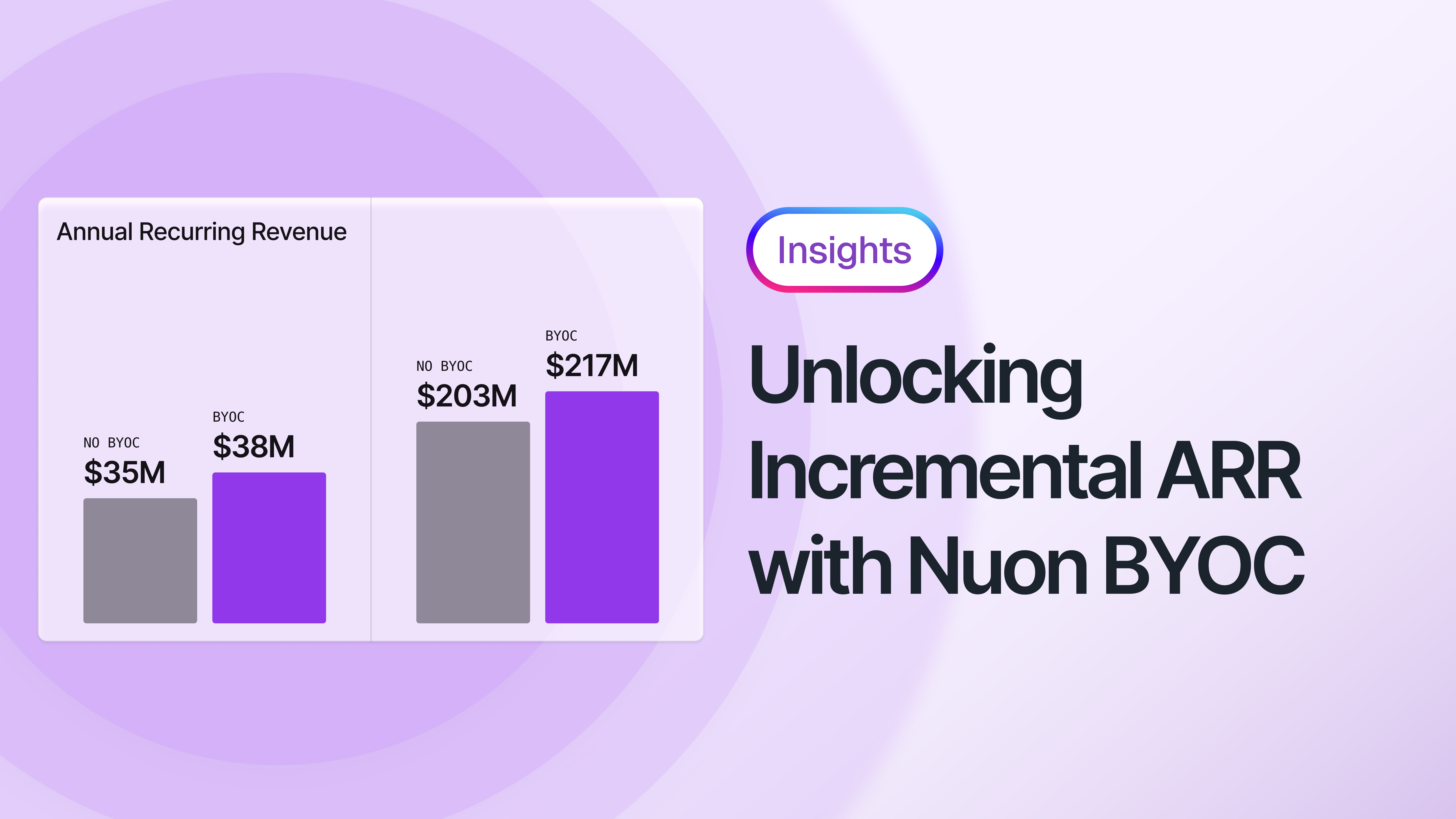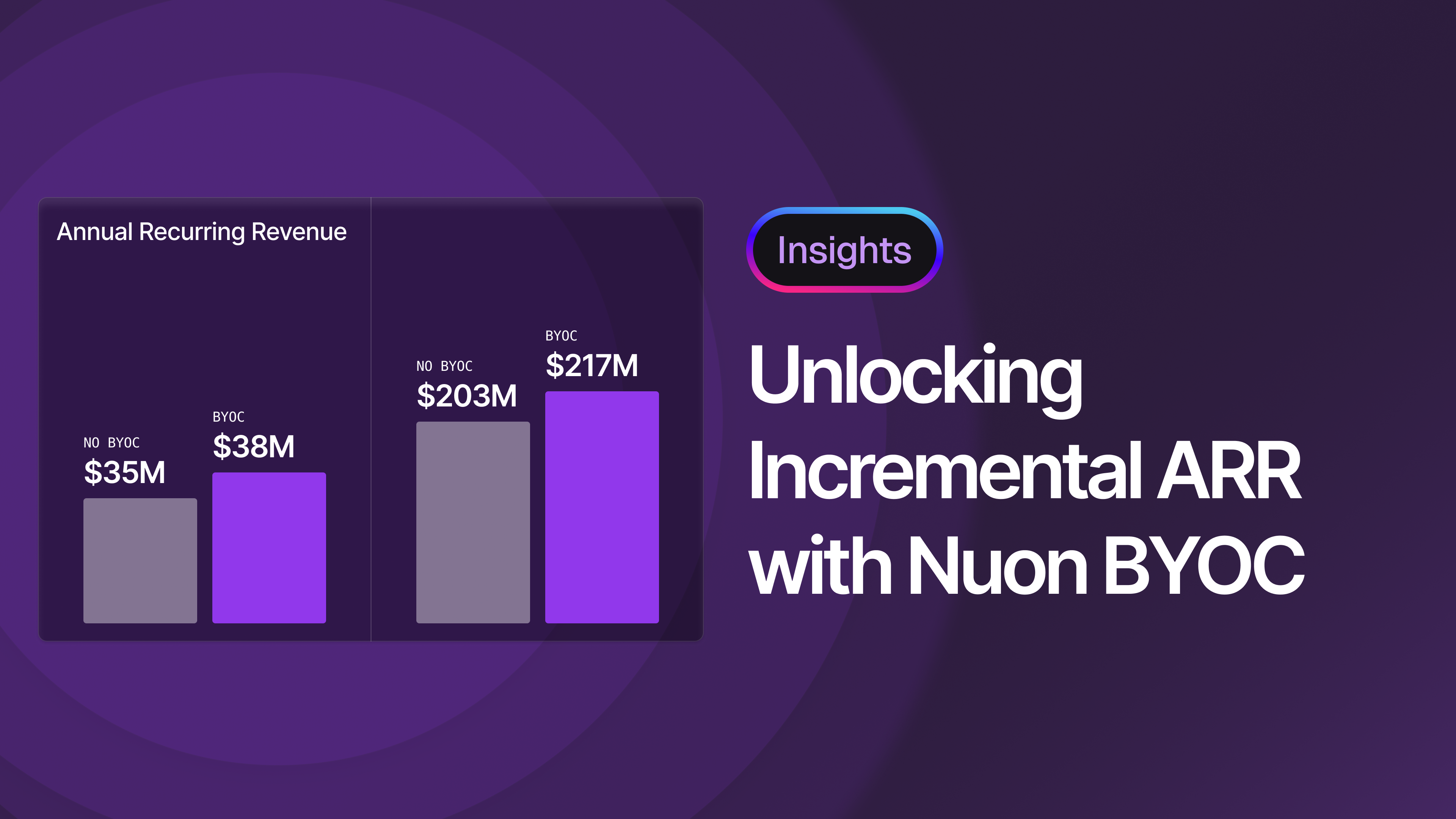Part 2: Unlocking Incremental ARR with Nuon BYOC
With Nuon's off-the-shelf Bring Your Own Cloud platform, grow ARR by adding customers who want self-hosted but vendor-managed.

Mark Milligan
VP of Revenue


Software vendors are always looking for ways to incrementally grow their Annual Recurring Revenue.
Strategies include building or acquiring new products, re-packaging features with modular, edition-based, add-on and feature-gating pricing, expansions by way of customer success and usage adoption, price increases, new pricing models such as the controversial outcomes-based or expensive consumption-based, and expanding into new markets and vertical industries.
Another way is offering various software deployment options that cater to specific customer types, one of which is Bring Your Own Cloud (BYOC).
BYOC Refresher
Historically, there have been three deployment models for vendor software.
Self-hosted, where the customer installs and manages the vendor software in the customer’s Virtual Private Cloud (VPC).
Fully managed Software-as-a-Service (SaaS), where the vendor installs and manages its software, in multi or single-tenant style, in the vendor’s VPC and the customer just accesses the software.
Self-hosted and vendor-managed, where the vendor installs and manages the software but in the customer’s VPC. This is also known as Bring Your Own Cloud (BYOC) and Nuon is the leader in providing an off-the-shelf BYOC software platform.
Self-hosted appeals to customers because their data never leaves their VPC. However the customer is on the hook to hire and retain DevOps staff to install and upgrade the software over time which is expensive.
Fully managed SaaS appeals to customers because they can obtain business value from the software but are not responsible for installation and upgrades. Vendors also like this model because they only have to maintain a limited number of versions of their software versus troubleshooting problems in customers’ self-hosted deployments.
Self-hosted and vendor-managed, aka BYOC, is the best of both worlds where customers sleep well knowing their data and software reside in their VPC and don’t have to worry about installation and upgrades, because the vendor remotely performs these tasks.
So Why Are More Vendors Not Offering BYOC?
As I outlined in the Part 1: Build vs. Buy blog post, it takes time and is very expensive to build and maintain an in-house BYOC offering. Therefore, a lot of vendors do not see a good Return on Investment. Other factors include economics and focus, operational overhead or product architecture constraints.
Off-the-shelf BYOC: Nuon
When the Internet took off, it wasn’t because companies were building their own web servers and eCommerce platforms. Instead, vendors were building off-the-shelf products that companies could easily deploy to create business value with eCommerce and Internet services. Using that analogy, Nuon enables the thousands of fully managed and self-hosted software vendors a turn-key option to quickly offer BYOC to their customers.
Which Customers Want BYOC?
Companies who can only procure self-hosted software will want BYOC, because it remains self-hosted, but vendor managed. Alternatively, companies who make exceptions or do not use fully-managed SaaS products, can now procure that software but in a secure BYOC manner.
What Does BYOC Mean For ARR?
If a software vendor procures licenses from and implements Nuon to quickly offer BYOC - you’ve instantly unlocked two customer segments and therefore pipeline and revenue streams. There are permutations to this.
A current customer is not expanding due to the complexities and burden of self-hosted or concerns over their data with fully managed SaaS.
Opportunities lost can be re-contacted through a BYOC marketing campaign or direct sales - to convert with BYOC.
Current opportunities in the pipeline may be moving slowly or stalled because of the resources required to even evaluate self-hosted software or delays and concerns by technology risk and security who are reviewing a fully managed SaaS offering.
What Is The Tipping Point To Move Forward with BYOC?
It may be death by a thousand cuts, where sales cycles take too long, expansions are smaller than expected, the churn percentage is unacceptable aka the leaky bucket where finding logos and revenue is imperative to make up for the lost revenue. Or it could be an event like a loss of big customer or new logo, who expressly did not want a fully-managed SaaS or dealing with setting up and maintaining self-hosted themselves.
A Vendor ARR Impact Example
Assume a software vendor with $20M in existing ARR, a 75% ARR growth rate, and average deal size of $150k, could add 20 net new customers with BYOC.
Assume an annual Nuon license cost of $200k, and an additional $121k in vendor DevOps labor costs to install and maintain BYOC customer installs and maintain the Nuon control plane and release management for a total annual Nuon cost of $321k.
In one year, there would be $3M in new BYOC ARR, with a Net Annual Financial Impact of $2.6M and a breakeven in 1 month. Without BYOC, the vendor would achieve $35M in ARR, and with BYOC, $38M in ARR.
Over three years, assuming a 45% annual BYOC ARR growth rate and a 45% annual Nuon cost growth rate, offering BYOC would drive $7.8M in incremental ARR. Three year ARR revised with BYOC would be $217M versus $203M without BYOC.
Appropriate Use
It's important to remember these examples offer a simplified look at incremental ARR expansion, designed to highlight the potential revenue upside of offering a BYOC deployment option for customers and investing in an off-the-shelf platform like Nuon. This example had conservative assumptions like only 20 new BYOC customers per year. If the distribution channels are there, the volumes may be higher. Conversely, average deal size may be lower (or higher) in your organization. We strongly encourage all prospects and customers to conduct their own detailed revenue planning calculations, as every business has unique revenue planning and organizational structure to accommodate a new deployment option. External factors like the economy, market conditions, and competition can directly and indirectly impact revenue forecasting.
Conclusions
Nuon BYOC offers software vendors a powerful, low-lift path to unlocking new streams of Annual Recurring Revenue by tapping into customer segments historically left behind—those with strict data residency, control, or procurement requirements. Instead of diverting precious engineering and DevOps resources to build a complex in-house BYOC solution, vendors can adopt Nuon’s off-the-shelf platform to quickly meet these demands, eliminate sales friction, and accelerate deal velocity. Whether reigniting stalled deals, recovering lost opportunities, or converting security-conscious prospects, Nuon turns BYOC into a high-leverage, ARR-generating growth lever. In an era where deployment optionality is becoming a competitive differentiator, Nuon makes BYOC not just possible—but profitable.